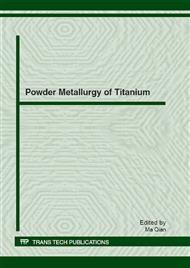p.89
p.95
p.101
p.111
p.121
p.133
p.139
p.145
p.153
Role of Surface Contamination in Titanium PM
Abstract:
The powder metallurgy (PM) approach is widely used for cost-effective production of titanium alloys and articles. In the PM approach the large specific surface of starting powders heightens the risk of excessive impurity presence and, hence, degradation of final alloy properties. The present study analyzes the opportunity to produce sintered commercially pure titanium (CP-Ti) with acceptable impurity content from powder materials. Starting titanium and titanium hydride powders were comparatively examined. The impurity elements (oxygen, chlorine, carbon) and their conditions on the powder particle surface, as well as the surface processes and gases emitted from powders upon heating, have been analyzed by means of surface science techniques. The role of hydrogen emitted from titanium hydride in material purification has been discussed. The opportunity to produce titanium materials with final admissible content of interstitials (O, C, Cl, and H) using starting titanium hydride powder has been demonstrated.
Info:
Periodical:
Pages:
121-132
Citation:
Online since:
August 2012
Keywords:
Price:
Сopyright:
© 2012 Trans Tech Publications Ltd. All Rights Reserved
Share:
Citation:


